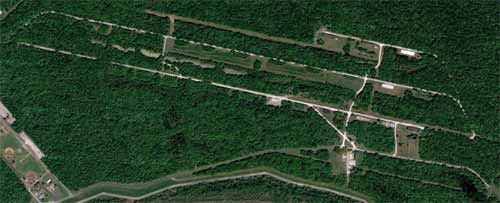Description of the Facility
The Royal D. Suttkus (RDS) Fish Collection and other facilities of TUBRI are housed in two bunkers on the grounds of the F. Edward Hebert “Riverside” Research Center, a former U.S. Navy munitions depot located on the west bank of the Mississippi River in Belle Chasse, Louisiana, 20 minutes from the uptown campus of Tulane.
In all there are 26 bunkers on the Hébert Center complex, 23 of which are World War II-vintage earthen bunkers designed for ammunition storage, and the remaining 3 of which are more modern, warehouse-type structures. The bunkers are arranged by size in three rows. Areas immediately surrounding the bunkers are mowed but most of the rest of the track is wooded. There is a string of borrow pits with standing water behind each row of bunkers. Both the wooded area and the borrow pits are being maintained as wild areas.

The bunkers at Riverside are elevated, heavily-reinforced concrete structures, ideally suited for collection storage. The back and sides of the bunkers are surrounded by an earthen berm, and a layer of dirt covers the roof. The ceiling slopes from 15 feet high in front to 13 feet high in back and is supported internally by numerous concrete pillars. The bunkers are capable of withstanding hurricane force winds; the structures were not marred in the least by Hurricanes Betsy and Katrina, which passed directly over the property. They are not susceptible to flooding of any kind, including a break in the levee of the adjacent Mississippi River, because the floor level is five feet above ground level. The floor loading capacity of the buildings is 2,000 lbs. per sq. ft.
The Fish Collection is split between two bunkers Bunker A-3, one of three 10,000 sq. ft. bunkers located at the rear (north) of the Hebert Center complex, and Bunker A-15, a 7,500 sq. ft. bunker directly behind (south) of Bunker A-3. The RDS fish collection was recurated over an 11-year period from 1994-2004 with support from three NSF collection-improvement grants. During the curatorial projects, the preservative (alcohol) used in the collection was changed from 50% isopropanol to 70% ethanol, most of the specimen jars were upgraded and a third of the collection, including all tank specimens, was moved to Bunker A-15. The work was performed by a number of curatorial assistants supported by the grants, and nine cohorts of high school interns who were supported on NSF Research Assistantships for Minority High School Student (RAMHSS) supplements during the summers from 1996-2004.

